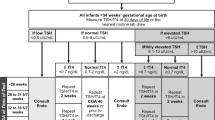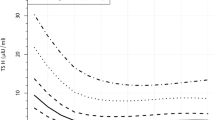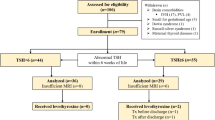Abstract
Thyroid hormone is essential for normal brain development including structures critical for visual processing. While chick and rodent models have demonstrated abnormal visual development following prenatal thyroid hormone loss, comparable data do not exist in the human. To determine whether human infants with intrauterine and early postnatal thyroid hormone insufficiencies have compromised visual abilities, we investigated contrast sensitivity and visual acuity development in 13 infant offspring of women with hypothyroidism during pregnancy (HYPO), 16 preterm infants born between 32 and 35 weeks gestation, 12 infants with congenital hypothyroidism (CH), and 20 typically developing infants. All were assessed with the sweep visual evoked potential technique at 3, 4.5, and 6 months (corrected) age. Results showed significantly reduced contrast sensitivity but normal visual acuity in HYPO and CH groups relative to controls (p < 0.003 and p < 0.05 respectively). Stratification of the HYPO group into subgroups based on maternal TSH levels during the first half of pregnancy revealed lower contrast sensitivities for infants whose mothers' TSH values were above than below the median (p < 0.05). In the CH group, those with an absent thyroid gland and/or a newborn TSH value above 200 mIU/L had lower contrast sensitivities than did those with other etiologies or TSH levels below 100 mIU/L (p < 0.05). There were no significant effects involving the preterm group. These results indicate that thyroid hormone is important for human visual development.
Similar content being viewed by others
Log in or create a free account to read this content
Gain free access to this article, as well as selected content from this journal and more on nature.com
or
Abbreviations
- CH:
-
congenital hypothyroidism
- COD:
-
coefficient of determination
- HSC:
-
The Hospital for Sick Children
- HYPO:
-
maternal hypothyroidism
- PREM:
-
preterm birth
- TH:
-
thyroid hormone
- VEP:
-
visual evoked potential
References
Bernal J, Nunez J 1995 Thyroid hormones and brain development. Eur J Endocrinol 133: 390–398
Potter BJ, Mano MT, Belling GB, McIntosh GH, Hua C, Cragg BG, Marshall J, Wellby ML, Hetzel BS 1982 Retarded fetal brain development resulting from severe dietary iodine deficiency in sheep. Neuropathol Appl Neurobiol 8: 303–313
Shapiro S 1966 Metabolic and maturational effects of thyroxine in the infant rat. Endocrinology 78: 527–532
Legrand J 1984 Effects of thyroid hormone on central nervous system development. Ophthalmic Physiol Opt 13: 9–16
Gilbert ME, Paczkowski C 2003 Propylthiouracil (PTU)-induced hypothyroidism in the developing rat impairs synaptic transmission and plasticity in the dentate gyrus of the adult hippocampus. Brain Res Dev Brain Res 145: 19–29
Rosman NP, Malone MJ, Helfenstein M, Kraft E 1972 The effect of thyroid deficiency on myelination of brain. A morphological and biochemical study. Neurology 22: 99–106
Koibuchi N, Chin WW 2000 Thyroid hormone action and brain development. Trends Endocrinol Metab 11: 123–128
Brent GA 2000 Tissue-specific actions of thyroid hormone: insights from animal models. Rev Endocr Metab Disord 1: 27–33
Forrest D, Reh TA, Rusch A 2002 Neurodevelopmental control by thyroid hormone receptors. Curr Opin Neurobiol 12: 49–56
Anderson GW 2001 Thyroid hormones and the brain. Front Neuroendocrinol 22: 1–17
Thompson CC, Potter GB 2000 Thyroid hormone action in neural development. Cereb Cortex 10: 939–945
Bradley DJ, Towle HC, Young WS 3rd 1992 Spatial and temporal expression of alpha- and beta-thyroid hormone receptor mRNAs, including the beta 2-subtype, in the developing mammalian nervous system. J Neurosci 12: 2288–2302
Morreale de Escobar G, Obregon MJ, Escobar del Rey F 2000 Is neuropsychological development related to maternal hypothyroidism or to maternal hypothyroxinemia?. J Clin Endocrinol Metab 85: 3975–3987
Howedeshell K 2002 A model of the development of the brain as a construct of the thyroid system. Environ Health Perspect 110: 337–348
Gamborino MJ, Sevilla-Romero E, Munoz A, Hernandez-Yago J, Renau-Piqueras J, Pinazo-Duran MD 2001 Role of thyroid hormone in craniofacial and eye development using a rat model. Ophthalmic Res 33: 283–291
Kelley MW, Turner JK, Reh TA 1995 Ligands of steroid/thyroid receptors induce cone photoreceptors in vertebrate retina. Development 121: 3777–3785
Knipper M, Zinn C, Maier H, Praetorius M, Rohbock K, Kopschall I, Zimmermann U 2000 Thyroid hormone deficiency before the onset of hearing causes irreversible damage to peripheral and central auditory systems. J Neurophysiol 83: 3101–3112
Sevilla-Romero E, Munoz A, Pinazo-Duran MD 2002 Low thyroid hormone levels impair the perinatal development of the rat retina. Ophthalmic Res 34: 181–191
Sjoberg M, Vennstrom B, Forrest D 1992 Thyroid hormone receptors in chick retinal development: differential expression of mRNAs for alpha and N-terminal variant beta receptors. Development 114: 39–47
Ng L, Hurley JB, Dierks B, Srinivas M, Salto C, Vennstrom B, Reh TA, Forrest D 2001 A thyroid hormone receptor that is required for the development of green cone photoreceptors. Nat Genet 27: 94–98
Baas D, Legrand C, Samarut J, Flamant F 2002 Persistence of oligodendrocyte precursor cells and altered myelination in optic nerve associated to retina degeneration in mice devoid of all thyroid hormone receptors. Proc Natl Acad Sci USA 99: 2907–2911
Ikeda A, Nishina PM, Naggert JK 2002 The tubby-like proteins, a family with roles in neuronal development and function. J Cell Sci 115: 9–14
Nguyen-Legros J, Versaux-Botteri C, Vigny A 1986 Early development of tyrosine hydroxylase-like and substance P-like immunoreactivity in the human fetal retina. Hum Neurobiol 5: 115–120
Rovet JF 1999 Congenital hypothyroidism: long-term outcome. Thyroid 9: 741–748
Man EB, Brown JF, Serunian SA 1991 Maternal hypothyroxinemia: psychoneurological deficits of progeny. Ann Clin Lab Sci 21: 227–239
Fisher DA, Klein AH 1981 Thyroid development and disorders of thyroid function in the newborn. N Engl J Med 304: 702–712
Chan S, Kachilele S, McCabe CJ, Tannahill LA, Boelaert K, Gittoes NJ, Visser TJ, Franklyn JA, Kilby MD 2002 Early expression of thyroid hormone deiodinases and receptors in human fetal cerebral cortex. Brain Res Dev Brain Res 138: 109–116
Calvo RM, Jauniaux E, Gulbis B, Asuncion M, Gervy C, Contempre B, Morreale de Escobar G 2002 Fetal tissues are exposed to biologically relevant free thyroxine concentrations during early phases of development. J Clin Endocrinol Metab 87: 1768–1777
Vulsma T, Gons MH, de Vijlder JJ 1989 Maternal-fetal transfer of thyroxine in congenital hypothyroidism due to a total organification defect or thyroid agenesis. N Engl J Med 321: 13–16
Burrow GN, Fisher DA, Larsen PR 1994 Maternal and fetal thyroid function. N Engl J Med 331: 1072–1078
Pop VJ, Kuijpens JL, van Baar AL, Verkerk G, van Son MM, de Vijlder JJ, Vulsma T, Wiersinga WM, Drexhage HA, Vader HL 1999 Low maternal free thyroxine concentrations during early pregnancy are associated with impaired psychomotor development in infancy. Clin Endocrinol (Oxf) 50: 149–155
Haddow JE, Palomaki GE, Allan WC, Williams JR, Knight GJ, Gagnon J, O'Heir CE, Mitchell ML, Hermos RJ, Waisbren SE, Faix JD, Klein RZ 1999 Maternal thyroid deficiency during pregnancy and subsequent neuropsychological development of the child. N Engl J Med 341: 549–555
Rovet J, Ehrlich R, Sorbara D 1987 Intellectual outcome in children with fetal hypothyroidism. J Pediatr 110: 700–704
Hanukoglu A, Perlman K, Shamis I, Brnjac L, Rovet J, Daneman D 2001 Relationship of etiology to treatment in congenital hypothyroidism. J Clin Endocrinol Metab 86: 186–191
Song SI, Daneman D, Rovet J 2001 The influence of etiology and treatment factors on intellectual outcome in congenital hypothyroidism. J Dev Behav Pediatr 22: 376–384
LaFranchi S 1999 Thyroid function in the preterm infant. Thyroid 9: 71–78
Rooman RP, Du Caju MV, De Beeck LO, Docx M, Van Reempts P, Van Acker KJ 1996 Low thyroxinaemia occurs in the majority of very preterm newborns. Eur J Pediatr 155: 211–215
Ares S, Escobar-Morreale HF, Quero J, Duran S, Presas MJ, Herruzo R, Morreale de Escobar G 1997 Neonatal hypothyroxinemia: effects of iodine intake and premature birth. J Clin Endocrinol Metab 82: 1704–1712
Reuss ML, Paneth N, Pinto-Martin JA, Lorenz JM, Susser M 1996 The relation of transient hypothyroxinemia in preterm infants to neurologic development at two years of age. N Engl J Med 334: 821–827
Lucas A, Morley R, Fewtrell MS 1996 Low triiodothyronine concentration in preterm infants and subsequent intelligence quotient (IQ) at 8 year follow up. BMJ 312: 1132–1133; discussion
Norcia AM, Tyler CW, Hamer RD 1990 Development of contrast sensitivity in the human infant. Vision Res 30: 1475–1486
Adams RJ, Courage ML 1990 Assessment of visual acuity in children with severe neurological impairments. J Pediatr Ophthalmol Strabismus 27: 185–189
Diamond A, Herzberg C 1996 Impaired sensitivity to visual contrast in children treated early and continuously for phenylketonuria. Brain 119: 523–538
Perron A, Westall CA, Mirabella G, Buncic JR, Logan WJ, Snead OC 2001 Contrast sensitivity changes in children prescribed the antiepileptic drug vigabatrin. Invest Ophthalmol Vis Sci 42: S388
Berghout A, Endert E, Ross A, Hogerzeil HV, Smits NJ, Wiersinga WM 1994 Thyroid function and thyroid size in normal pregnant women living in an iodine replete area. Clin Endocrinol (Oxf) 41: 375–379
Rovet J, Daneman D 2003 Congenital hypothyroidism: a review of current diagnostic and treatment practices in relation to neuropsychologic outcome. Paediatr Drugs 5: 141–149
Norcia AM, Tyler CW, Allen D 1986 Electrophysiological assessment of contrast sensitivity in human infants. Am J Optom Physiol Opt 63: 12–15
Harding GFA, Odom JV, Spileers W, Spekreijse H 1996 Standard for the visual evoked potential. Vision Res 36: 3567–3572
Norcia AM 2001 PowerDiva Manual (Version 1.5). Smith-Kettlewell Eye Research Institute, San Francisco, pp 2–31I
Norcia AM, Tyler CW, Hamer RD, Wesemann W 1989 Measurement of spatial contrast sensitivity with the swept contrast VEP. Vision Res 29: 627–637
Norcia AM, Tyler CW 1985 Spatial frequency sweep VEP: visual acuity during the first year of life. Vision Res 25: 1399–1408
Norcia AM, Tyler CW, Hamer RD 1988 High visual contrast sensitivity in the young human infant. Invest Ophthalmol Vis Sci 29: 44–49
Howell DC 1997 Simple analysis of variance. In: Statistical Methods for Psychology. Wadsworth Publishing Co, Scarborough, Canada, pp 275–323
Saunders KJ, Westall CA 1992 Comparison between near retinoscopy and cycloplegic retinoscopy in the refraction of infants and children. Optom Vis Sci 69: 615–622
Norcia AM, Tyler CW, Piecuch R, Clyman R, Grobstein J 1987 Visual acuity development in normal and abnormal preterm human infants. J Pediatr Ophthalmol Strabismus 24: 70–74
Regan D 1989 Basic research. In: Human Brain Electrophysiology: Evoked Potentials and Evoked Magnetic Fields in Science and Medicine. Elsevier Science Publishing Co, New York, pp 167–482
Johnson MH 2000 Functional brain development in infants: elements of an interactive specialization framework. Child Dev 71: 75–81
Braddick OJ, O'Brien JM, Wattam-Bell J, Atkinson J, Turner R 2000 Form and motion coherence activate independent, but not dorsal/ventral segregated, networks in the human brain. Curr Biol 10: 731–734
Acknowledgements
The work was obtained in partial fulfillment of G.M. doctoral thesis.
Portions of this paper were presented at conferences of the American Thyroid Association, September 2002, Los Angeles, CA; Association of Research in Vision and Ophthalmology, May 2002, Fort Lauderdale, FL; the International Society of Infant Studies, April 2004, Chicago, IL; the International Neuropsychology Society, February 2003, Honolulu, HI; Neurotoxicology, February 2004, Honolulu, HI.
We are indebted to Julie Cunningham for recruiting and scheduling the children and to Adena Perron, who assisted in testing. We also thank Dr. Wendy Wolfman, who allowed us to recruit control mothers through her obstetrics practice; Lori Brnjac, who recruited many of the children with CH; Dr. Michael Simone, from whom we obtained two of the CH cases; and the Motherisk Program at HSC, from which we recruited the hypothyroid women. We are also extremely grateful to Dr. Anthony Norcia and members of his laboratory, who provided the software as well as the direction and guidance in using the Power Diva System. Finally, we thank all of the mothers and their infants who so willingly participated in this research.
Author information
Authors and Affiliations
Corresponding author
Additional information
This work was supported by a RESTRACOMP scholarship through the Research Institute of The Hospital for Sick Children (G.M.), an operating grant from the Canadian Institutes of Health Research (J.R.), and a National Science and Engineering Research Council postdoctoral fellowship (G.M.).
Rights and permissions
About this article
Cite this article
Mirabella, G., Westall, C., Asztalos, E. et al. Development of Contrast Sensitivity in Infants with Prenatal and Neonatal Thyroid Hormone Insufficiencies. Pediatr Res 57, 902–907 (2005). https://doi.org/10.1203/01.PDR.0000157681.38042.B4
Received:
Accepted:
Issue date:
DOI: https://doi.org/10.1203/01.PDR.0000157681.38042.B4
This article is cited by
-
Ocular morphology development and function in children with congenital hypothyroidism diagnosed by neonatal screening
Endocrine (2021)
-
Neurophysiologic evaluation of infants with congenital hypothyroidism before and after treatment
Acta Neurologica Belgica (2015)
-
Making sense with thyroid hormone—the role of T3 in auditory development
Nature Reviews Endocrinology (2013)
-
Paradoxical robust visual evoked potentials in young patients with cortical blindness
Documenta Ophthalmologica (2009)



